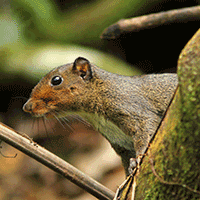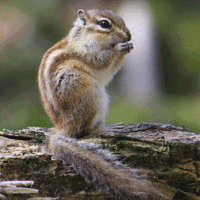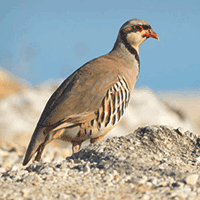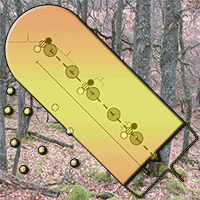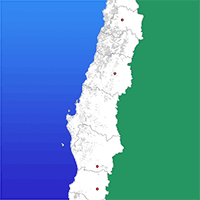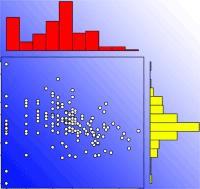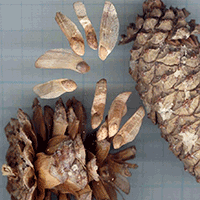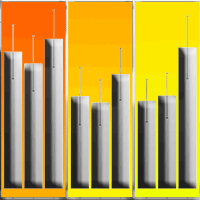
What if Eurasian jay Garrulus glandarius would larder acorns instead of scatter them?
Przemyslaw Kurek (1) , Dorota Dobrowolska (2), Blanka Wiatrowska (3), Lukasz Dylewski (4)
iForest - Biogeosciences and Forestry, Volume 11, Issue 5, Pages 685-689 (2018)
doi: https://doi.org/10.3832/ifor2793-011
Published: Oct 23, 2018 - Copyright © 2018 SISEF
Research Articles
Abstract
Jays usually store acorns at separate sites, but in some cases a part of jay’s caches consists of more than one acorn. Storing acorns separately (scatter hoarding) or in clusters (larder hoarding) seems to be an important factor for further survival of seeds and seedlings. Scatter hoarding is favorable for jays, but what would happen if jays prepared caches consisting of more than one acorn? We put a following question: what is the importance and impact of acorn concentration per cache for the seedlings’ mortality and their growth characteristics? In 2013 an experimental plot was established. 1400 acorns of Quercus robur L. were sewed in 600 holes in three combinations called growing mode - singly, in twos and in fours. The mortality of seedlings depended on growing mode (Z = 6.24, P < 0.001) and year (Z = -2.42, P = 0.016). In the third year of the experiment the mortality of seedlings growing from acorns sewed in fours reached almost 90%, while in the case of seedlings growing separately the mortality was stable, reaching no more than 23%. Both growing mode (F = 26.49, P < 0.001) and year (F = 52.59, P < 0.001) had a significant impact on seedling growth increment. Seedlings growing in fours had a significantly higher growth increment than these growing separately and in twos. We concluded that seedlings growing separately had a higher survival rate, but lower growth increment than those coming from acorns sewed in clumps.
Keywords
Eurasian Jay, Acorns, Scatter Hoarding, Larder Hoarding, Seedlings Survival, Seed Dispersal
Authors’ Info
Authors’ address
Department of Plant Ecology and Environmental Protection, Adam Mickiewicz University, Umultowska 89, 61-614 Poznan (Poland)
Department of Forest Ecology, Forest Research Institute, Braci Lesnej 3, 05-090 Sekocin Stary (Poland)
Department of Forest Botany, Poznan University of Life Sciences, Wojska Polskiego 71D, PoznaÅÂ 60-625 (Poland)
Institute of Zoology, Poznan University of Life Sciences, Wojska Polskiego 71C, Poznan 60-625 (Poland)
Corresponding author
Paper Info
Citation
Kurek P, Dobrowolska D, Wiatrowska B, Dylewski L (2018). What if Eurasian jay Garrulus glandarius would larder acorns instead of scatter them?. iForest 11: 685-689. - doi: 10.3832/ifor2793-011
Academic Editor
Massimo Faccoli
Paper history
Received: Mar 20, 2018
Accepted: Aug 02, 2018
First online: Oct 23, 2018
Publication Date: Oct 31, 2018
Publication Time: 2.73 months
Copyright Information
© SISEF - The Italian Society of Silviculture and Forest Ecology 2018
Open Access
This article is distributed under the terms of the Creative Commons Attribution-Non Commercial 4.0 International (https://creativecommons.org/licenses/by-nc/4.0/), which permits unrestricted use, distribution, and reproduction in any medium, provided you give appropriate credit to the original author(s) and the source, provide a link to the Creative Commons license, and indicate if changes were made.
Web Metrics
Breakdown by View Type
Article Usage
Total Article Views: 48100
(from publication date up to now)
Breakdown by View Type
HTML Page Views: 41470
Abstract Page Views: 2824
PDF Downloads: 2934
Citation/Reference Downloads: 6
XML Downloads: 866
Web Metrics
Days since publication: 2613
Overall contacts: 48100
Avg. contacts per week: 128.86
Citation Metrics
Article Citations
Article citations are based on data periodically collected from the Clarivate Web of Science web site
(last update: Mar 2025)
Total number of cites (since 2018): 4
Average cites per year: 0.50
Publication Metrics
by Dimensions ©
Articles citing this article
List of the papers citing this article based on CrossRef Cited-by.
References
Aggregation of Prunus ilicifolia (Rosaceae) during dispersal and its effect on survival and growth. Madrono 28: 94-95.
Gscholar
The ecology and sylviculture of oaks. Centre for Agriculture and Bioscience International, Oxfordshire, Cambridge, UK, pp. 81-93.
Gscholar
Geografia regionalna Polski [Regional geography of Poland]. PWN Publisher, Warsaw, Poland, pp. 103-107. [in Polish]
Gscholar
Synzoochoryczne rozsiewanie zoledzi przez sójki Garrulus glandarius na powierzchniach zrebowych oraz pod drzewostanem [Acorns dispersal by jays Garrulus glandarius onto clear-cuts and under the forest canopy]. Sylwan 160: 512-518. [in Polish]
Gscholar
Predation and dispersal of acorns by European Jay (Garrulus glandarius) differs between a native (Pedunculate Oak Quercus robur) and an introduced oak species (Northern Red Oak Quercus rubra) in Europe. Forest Ecology and Management 331: 35-39.
CrossRef | Gscholar
ggplot2: Elegant graphics for data analysis. Springer-Verlag, New York, USA, pp. 1-90.
Gscholar

